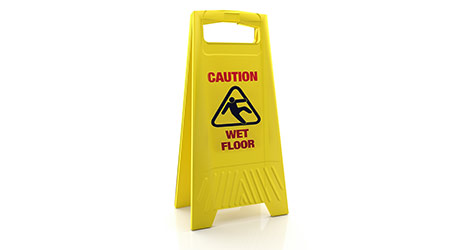
One of the best ways to speed up the drying process is to use air movers that circulate air across the surface of the carpet.
According to Griffin, there are two types of fans for drying carpets: axial and centrifugal. Axial fans are suitable for large spaces and move air in all directions when positioned so that air flows downward. Centrifugal fans are suitable for smaller rooms or hallways and focus the air in a specific direction.
Poole suggests placing fans 12 to 15 feet apart and angling them toward the cove base in confined spaces or hallways. "You want to make sure you're sending air along the baseboards so that you're hitting the lower portions of the walls, as well," he says. "If you're drying a hallway, make sure you have a fan at either end."
Distributors also warn customers not to close up the room while the carpet is drying.
"Remember, the moisture has to go somewhere," says Rathey. "The air will hold it for a while, but then you need to remove the moisture from the air."
Griffin recalls an occasion when a school closed its rooms as soon as the custodian had finished cleaning the carpets. When the school reopened in the fall, the carpets had developed mold.
"You can't close moisture in a room that has no way of getting out," he says. "If you do, the room will stay moist for a longer period of time and that gives mold a chance to grow."
High humidity and low temperatures can also prolong dry times, which is why facilities need to factor these variables into the drying process.
Rathey uses the acronym HAT to remember the three principles of drying carpets: humidity, air movement and temperature. He recommends facilities purchase a relative humidity meter to measure the room's humidity. If the reading is higher than 50 percent, then the atmosphere may prevent the carpet from drying properly. This, in turn, could foster the growth of microorganisms that could potentially become airborne.
When indoor humidity is high, facilities may need to run air conditioning and use a dehumidifier to remove moisture from the air as the carpet dries. If the weather is cold, staff can turn up the heat and run a dehumidifier, as well as fans, if needed.
Proper ventilation is also imperative to speed up the drying process.
"If it's hot and dry outside, you can open windows — unless it's a commercial building and you have security issues," notes Rathey. "If that's the case, you want to make sure there's some outdoor air exchange. Speak to the person responsible for the heating, ventilation and air conditioning system and find out whether or not it uses recirculated air."
Sometimes custodians make the mistake of opening windows to dry carpets when the outdoor air is humid.
"If you're in a really humid area and you open the window, you might be letting more humidity in than out," says Griffin. "If it's raining outside, for instance, you might want to leave the windows closed. Instead, turn on the heat and run some fans to speed up the drying process."
In Case Of Emergency
Waiting for carpets to dry is often an exercise in patience. Carpets may look dry when in fact they are not, which is why custodians should feel them to test for dampness.
Poole likes to err on the side of caution: "They must be dry to the touch — and that means pushing down on them to make sure you didn't get too much water underneath the carpet into the base," he says.
In addition to feeling the fibers, he recommends walking on the carpet while wearing shoes.
"I make sure I walk along the edges of the carpet against the walls, as well as in the middle," he says. "If my shoes are dry after I step off the carpet, I feel pretty confident that it's completely dry."
Fortunately, cleaning and drying carpets is a fairly straightforward process — but sometimes accidents happen. In the unlikely event of a flood or leak, facility cleaning managers may find their staff ill-equipped to handle excess water and soggy carpets.
"This is where judgment and experience come into the process," says Poole. "Companies need to recognize when it's best to call in a specialist."
Poole speaks from personal experience. While he was working as a project manager, someone in the building left a faucet on in the janitor's closet. Over the course of several hours, the water caused damage to ceiling tiles and carpets on multiple floors.
"We had managers and wet vacs from all over the city, but the water kept spreading," says Poole.
When the integrity of the electrical wiring was called into question, he knew it was time to call it quits. Finally, management decided to bring in a restoration company.
"We were looking at major damage and electrical concerns, and the situation was out of our purview," says Poole. "You have to recognize your limitations and do what is best for the company."
Kassandra Kania is a freelance writer based in Charlotte, North Carolina.
Protect Carpets With Proper Dry Times

 The Down and Dirty on Cleaning in Virus Season
The Down and Dirty on Cleaning in Virus Season How Surfactant Use is Expanding in Commercial Cleaning
How Surfactant Use is Expanding in Commercial Cleaning